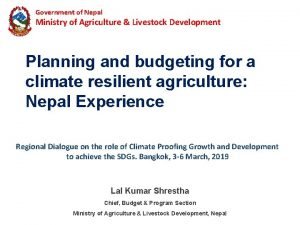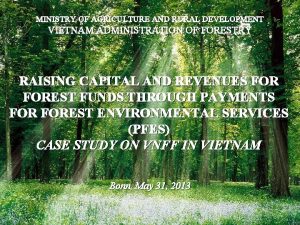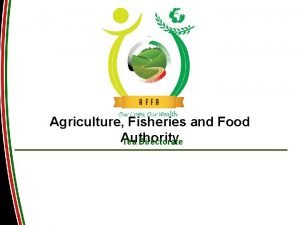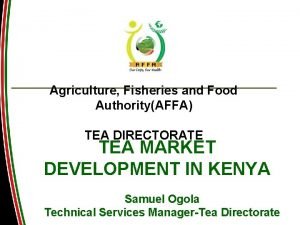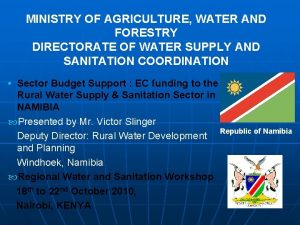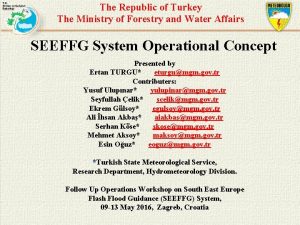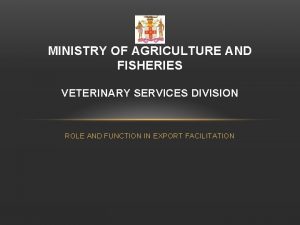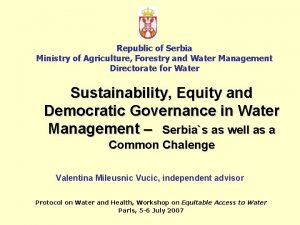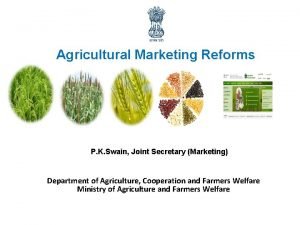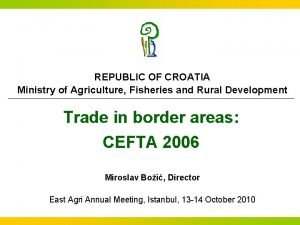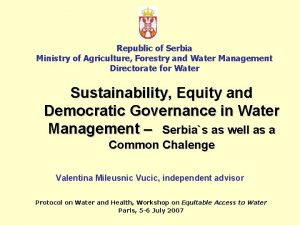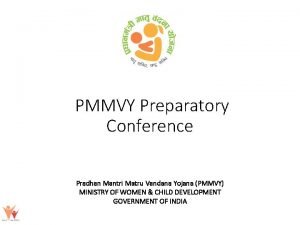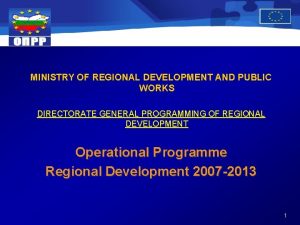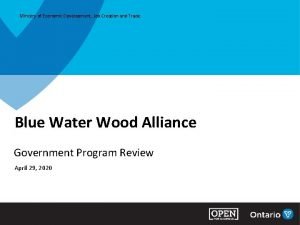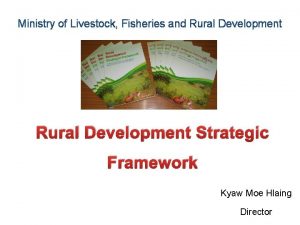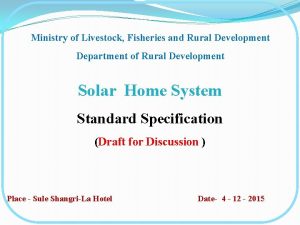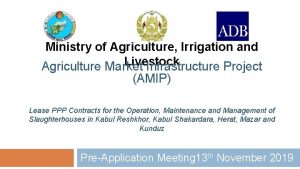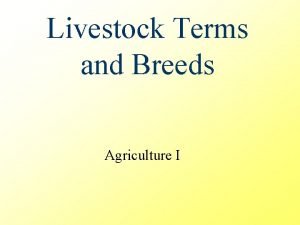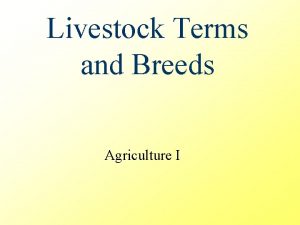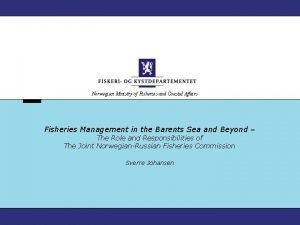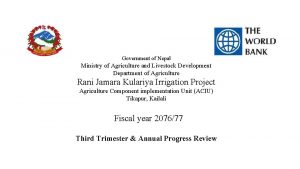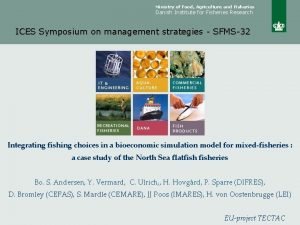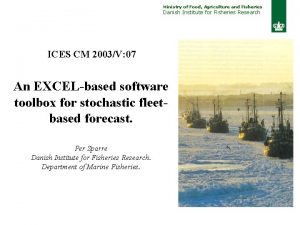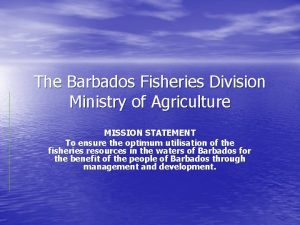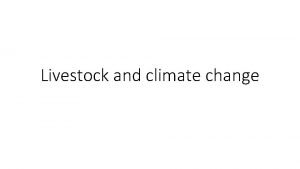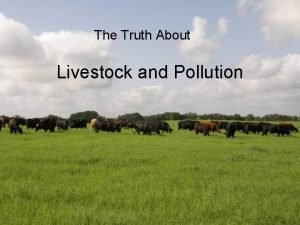Ministry of Agriculture Livestock and Fisheries Agriculture Development























- Slides: 23

Ministry of Agriculture Livestock and Fisheries Agriculture Development and Its Contribution To Transform Tanzania Towards Becoming a Middle Income Country By 2025

Scope of Presentation • An overview of the Agricultural Sector • Middle Income Countries – (MICs) • Agriculture – Industry Inter-linkages • Agric Sector Feature and Performance; • On going Strategies, programs and other Initiates • Sector Achievement • Challenges • Investments Required for Transformation • Role of Engineers in Agric’ Development • Way forward and Conclusion

Overview of the Sector Performance • • Agricultural sector is and will continue to remain the foundation of the economy for Tanzania. Yr 2015 the sector accounted for: – – – • 29 per cent of the GDP, Provides about 100 percent of domestic food requirement; in 2014 it was 125 percent Employs about 65. 5 per cent of the population and provides a substantial amount of raw materials for industries; Therefore, the sector has potential to lift many of the poor people out of poverty and contribute to achieving our development goal of graduating into the middle income economy by 2025.

Middle Income Countries (MTCs) • WB uses the GNI as a basis for classification of Country position - (Income growth) • MIC – Nation with per capita- GNI ($1, 045 to 12, 736 by 2014); • Income growth features – Increase in agric productivity pushes labour away from farms to industry and services sector; – Urban population expands as a share of the total population; – Expenditure share on food declines

Agriculture – Industry Inter-linkages • Agric and Industry are integral components of Dev process- mutual interdependence and symbiotic relationship; • Two types of beneficial Inter-linkage – The forward linkage is on how the sector distributes its output (raw crops –cereals , sugar, tea, cotton etc, and; – Backward linkages is related to DD relationship of facilities for agricultural activities (land prep’, planting, weeding, harvesting processing, storage etc); • Improvement in Agric creates strong DD incentive for industrial consumer goods and generates surplus saving for industrial investments

Sector performance. . . The sector has maintained a steady growth rate of over 4% which is above population growth of 2. 8%

91% of agriculture land in use is driven by smallholders; only 9% of land is used commercially 44 million hectares Arable land 14 million hectares Smallholders ▪ Smallholders average farm size is 0. 2 to 2 hectares ▪ The main source of income is sales of food crops 1. 5 million hectares Commercial farming 1 ▪ There are 1, 006 large scale farms in Tanzania with the average size of 1, 107 hectares 1 Commercial farms are defined as land size 20 Ha and above SOURCE: National Sample Census of Agriculture

Potential for irrigation. Irrigation Potential i. Irrigation potential estimated to be 29. 4 million ha, out of which 2. 3 million ha of high potential, 4. 8 million ha medium potential and 22. 3 million ha of low potential suitable for irrigation. ii. Only 461, 326 is used about 1. 6% iii. Only less than 5% of households use irrigation facilities Irrigation i Mitigates vagaries of weather; ii Yield is more than 2 -3 times compared to rain-fed; 8

Level of Mechanisation Draft Aniamal 14% Tractors 24% Hand hoe, 62%

Input accessibility Seed Fertilizer 2014/2015/2016 DEMAND 60, 000 MT 60, 000 485, 000 MT 485, 000 AVAILABILITY 36, 410 MT 36, 482 342, 798 MT 302, 450 GAP 23, 590 MT 23, 518 142, 202 MT 182, 550 60. 7% 60. 8% 70. 7% 62. 3% %

Technological advancement for increased productivity • Central to accelerating agricultural growth; Years Variety released Breeders Seed Supplied (MT) 2011/2012 16 29. 2 28, 770. 2 2012/2013 22 17. 4 30, 403. 9 2013/2014 27 217. 8 32, 339. 9 2014/2015 48 14. 2 36, 410. 0 2015/2016 29 8. 2 36, 482. 0

Human capital Development in the sector • Target to have 1 extension officer in every village which sum up to 20, 374 by 2020 YEAR Available YEAR 2013/2014/2015/2016 7, 974 8, 558 8, 756

Agro-processing • The level of agro-processing is still low - highly associated with poor infrastructure (among others); • Limited long term financing though; the establishment of TADB has lessening the problem of capital; • some policies limit development in agro-processing which makes the agroprocessing industry to fail meeting the employment creation targets • • • The country continues to export a large share unprocessed agro-products; Supply constraints -insufficient amount of produce to meet requirements Locked potentials – There is still room for expansion though processing of maize, tea and wheat is encouraging due to establishment of new facilities and more efficient use of capacity previously owned by public corporations. – Milk processing plants and processed milk increased between (20012015), though there is still a huge potential to expand the milk industry (1. 5 billion litres/year), as only 20 percent is collected and processed. – The number of hides and skins processing facilities has increased between 2001 and 2015, with the capacity to meet 52 percent of the total production.

Strategies and Programmes……. . POLICY TIME FRAME INITIATIVE KILIMO KWANZA SAGCOT TAFSIP BRN ASDP II Area of Focus Ten Pillars; National Vision; Financing; Institution 2009 -No time Reorganization; Paradigm shift; land; incentive, bound industrialization, science and Tech, HR, infrastructure and mobilizing Tanzanian. It seek to focus on public and private intervention to engage 2010 -2030 the smallholders in commercial farming Seven thematic areas; Irrigation Dev’ and sustainable Water Resources and Land Use Mgt; Prod’ and Rural Commercialization; Rural infrastructure market access and 2011 -2021 Trade; Private Sector Development; Food and Nutrition sec; Disaster Mgt, climate change; Policy Reform and Institution support Three KPI; Promoting 25 commercial farming deals; Originally 3 yrs Enhancing 78 smallholder rice irrigation Schemes; and 2013 - 2016 275 COWABAMA 2016/2017 – Increase productivity, profitability and farm income; Promote 2024/2025 private sector investment ; and address cross cutting issues

Sector- Achievement Some of the notable achievements of the agriculture sector through the various initiatives have included; • Promotion of private sector participation in agriculture – By 2014/2015 a total of 71 institutions were engaged in SAGCOT projects with a total investments USD 300 M (ie YARA, KPL, Seed-Co , Silver lands, Mtanga Food, TAHA etc. . . ) • Improvement in crop productivity – e. g maize from the average 0. 5 ton/ha to ha in 2007/08 to 2. 0 ton/ha in 2013/2014 and paddy from 0. 8 ton/ha to 2. 5 ton/ha; and to 4. 0 ton/ha under irrigation in the same period; • Availability of Improved seeds and fertilizers. – Availability of fertilizer increased from 211, 013 MT in 2007/08 to 302, 450 MT in 2015/2016. – On the other hand the availability of improved seeds marked 36, 482 in seasons 2015/16 from as low as 16, 621. 12 MT of improved seeds in 2007/08.

Sector- Achievement Cont. . • Irrigation Development; – Area under irrigation increased from 249, 992 in 2008/2009 to as high as 436, 326 ha in 2015/2016; • Domestic production of food; – 2009/2010 (103%), 2010/2011 (111%), 2011/2012 (111%), 2012/2013 (113%), 2013/2014 (118%) and 2014/2015 (125%). – Since food account for large portion of the household spending, such improvement reduces the inflation rate from 7. 01 in 2006 to as low as 5. 56 in 2010 and this reduced the cost of living for the majority of HH. • Establishment of Tanzania Agricultural Development Bank (TADB) – A total of 60 bn Tsh were issued as start up capital to the TADB; – It was launched in 2014 and now operational

Sector- Achievement Cont. . • Utilization of Improved crop Varieties; – In just past fiver years (2011 -2015) a total of 142 new varieties were developed; • Use of Agric Mechanization; – Increased farmers’ access to and use of agric mechanization- the number of tractor increased from 2, 580 in 2005 to 14, 200 in 2014; power tillers from 497 to 6, 741 same period • Development of agricultural marketing system and infrastructure; – Several warehouse were constructed and rehabilitated e. g in year 2015 under COWABAMA a total 68 warehouse were constructed and benefited about 13, 800 farmers Human Resources Development and technology transfer – Public extension officer increase from 3, 379 to 8, 756 between 20072015 •

Challenges • Low productivity of land, labour and production inputs; • Over dependency on rain-fed agriculture and underdeveloped irrigation potential; • Limited capital and access to financial services for the uptake of technologies; • Inadequate support services - agricultural training, research and extension services; • Inadequate rural infrastructure including roads, utilities, markets, bridges etc and low agro-processing facilities utilization; • Crop pests and diseases about 30 -40 percent is lost due to pre and post harvest losses • Climate change and erosion of natural resource base and environmental degradation; • Inadequate participation of private sector and Weak producers’ organizations

Investments Required • The Development framework for agric transformation is ASDP -2; • Envisaged to increase sector growth to 6 percent annum – Sustainable Water and Land Use Management (irrigation dev, land use planning, charcoal dam & boreholes, soil fertility mgt, pasture dev etc 1, 450, 593 (Tsh M) – Enhanced Agric Productivity and Profitability (priority -crops, livestock and fisheries across the value chain- 1, 517, 960 (Tsh. M) – Rural Commercialization and Value Addition – competitive commodity value chain- Private sector engagement – 1, 483, 429 (Tsh. M); – Strengthening Sector Enablers at national region and local levelimprove policies and regulatory framework, institution capacity, coordination, M&E and statistics, Food and Nutrion Sec , Safety nets including early warning)

Main Features of ASDP - 2 I. It recognizes all initiatives in the sector ( both Public and Private) and it captures all actors in the sector and their investments II. ASDP-2 has elevated the role of private sector contribution as an engine of growth - We believe without private sector the country cannot develop - Role of the Government is to create enabling environment such as insuring financial accessibility from financing institutions III. ASDP-2 enhanced coordination to make sure that the sector is well coordinated in both public and private sectors IV. ASDP-2 ‘s implementation will focus across the value chain unlike the ASDP-1 20

Role of Engineers in Promotion Agric Dev • • Technology plays big role in Agric- Time and production is important – have to plant on time, harvest on time and deliver to store on time; Roles i. iii. iv. v. viii. ix. x. xi. Research and Design – machines for land preparation, planting, processing and packaging; Training and after sales services – machines suits different environment and soils; Quality Control – Important to regulate – quality of tractor, irrigation infrastructures or equipments such as disc plough etc Equipment and machines customerization to local environment – different suppliers using different technologies- areas specific not compatible to local areas; Preparation of Operational Manual and guidelines; - Using local language; Building Irrigation and Drainage Infrastructure; Assembling and Mounting of Equipments; Operation and Maintenance - Machines, Tractors (not normal drivers) Promotion of use of Agric Machines and Equipments - Suited to local areas; Design and Building of Warehouse and Other Farm Structure- considering heating, cooling, ventilation, logistics ; Building Other Infrastructure – roads, dams, charcoal dames boreholes etc

Way forward and Conc. • Economic transformation is about structural change in the economy, lesser agric contribution to GDP and greater from industrial and services • Transition to middle income is associated with increased productivity, releasing labour from farms to manufacturing industry; • Transforming agric is priority, the Got will use the ASDP 2 which sets a roadmap to transform the sector; • ASDP 2 recognize all initiative (public and private) – captures all actors in the sector, It has elevated the role of private sector, and considers development of the sector along the value chain; – Establishment TADB to make sure credits are available and affordable to farmers at manageable costs; – Recruitment of technical staff is of paramount importance to sustain sector growth; Plans is to recruit a total of 20, 374 by 2020 from the current available officers 8, 756 in 2016;

Thank you for your attention
 Ministry of agriculture and livestock development nepal
Ministry of agriculture and livestock development nepal Ministry of food agriculture and fisheries denmark
Ministry of food agriculture and fisheries denmark Ministry of agriculture and rural development cameroon
Ministry of agriculture and rural development cameroon Ecotourim
Ecotourim Tea directorate
Tea directorate Rules of natural justice
Rules of natural justice Tea directorate kenya
Tea directorate kenya Alaska fisheries development foundation
Alaska fisheries development foundation Ministry of agriculture, water and forestry directorates
Ministry of agriculture, water and forestry directorates Eturgu
Eturgu Ministry of agriculture veterinary services division
Ministry of agriculture veterinary services division Ministry of agriculture serbia
Ministry of agriculture serbia Ministry of
Ministry of Ministry of agriculture croatia
Ministry of agriculture croatia P k swain ministry of agriculture
P k swain ministry of agriculture Ministry of agriculture slovenia
Ministry of agriculture slovenia Ministry of agriculture croatia
Ministry of agriculture croatia Ministry of agriculture serbia
Ministry of agriculture serbia Ministry of community development
Ministry of community development Ministry of women and child development logo
Ministry of women and child development logo Ministry of regional development and public works
Ministry of regional development and public works Ministry of regional development and public works
Ministry of regional development and public works Swodf
Swodf сплит institute of oceanography and fisheries
сплит institute of oceanography and fisheries
